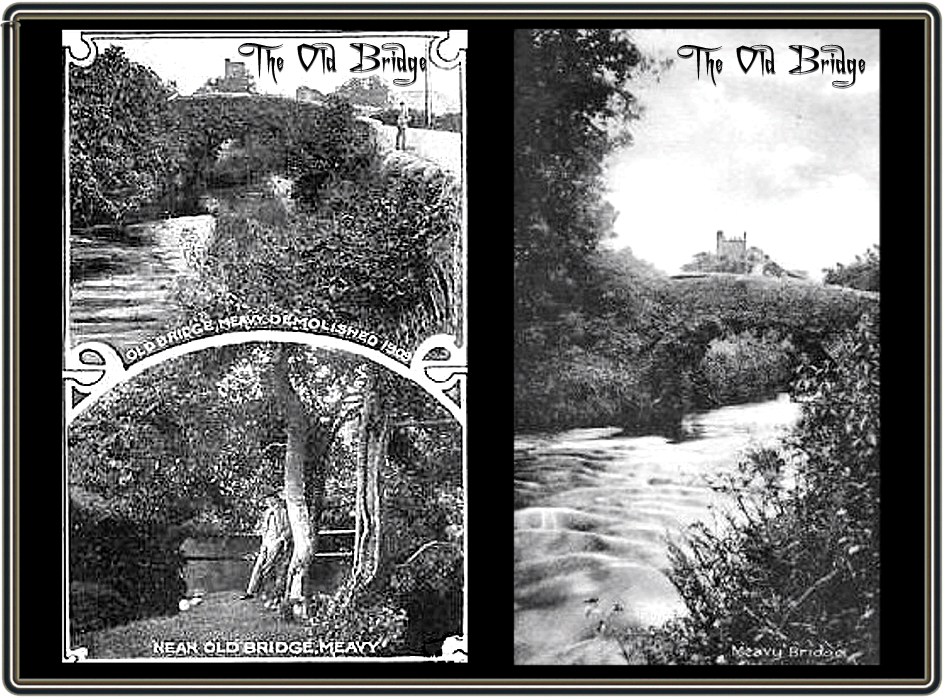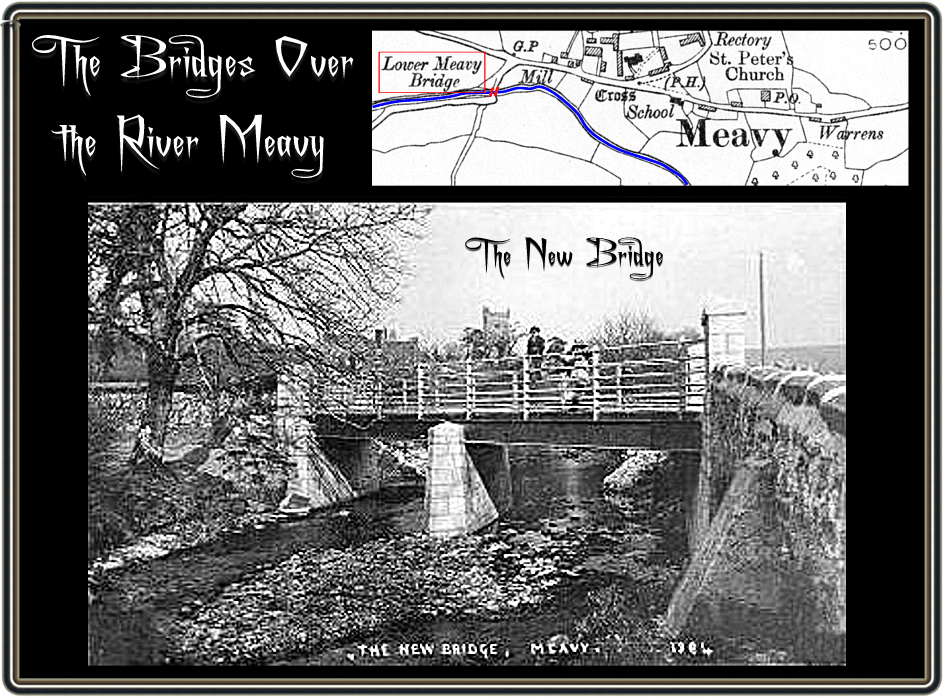
“Lower Meavy Bridge was once a picturesque ivy-covered stone arch bridge but was replaced by an iron construction in 1909, and was from then known as Iron Bridge.”
Pauline Hemery, The Book of Meavy, p.21.
Dartmoor has many fine examples of early bridges all of which carried ancient routes used by travellers and carriers alike, some on foot and other on or with horses and ponies. However, as road traffic increased in size and weights many have, at best been ‘modernised’ and in some cases completely disappeared. The old ‘Lower Meavy Bridge’ which spanned the River Meavy to the west of Meavy Village is a prime example of those lost for ever. To the villagers credit they put up a strong fight to keep the bridge but sadly they were over-ruled by the local authorities of the time. As can be seen from the old postcards below there can be no comparison between the old picturesque bridge and the ‘Iron Bridge’ which replaced it.
Henderson and Jervoise state that in the Session Books of 1665 record how repairs to Lower Meavy Bridge were necessary for at that time the road was a mere eight feet wide. Earlier to that there was a record from 1602 which mentioned; “Newe Bridge in the pish of Mevie,” but it is not certain which of the three bridges in the Meavy area it referred to? pp. 18 – 19. Either way there can be no doubt that the early bridge was an important river crossing of the time and an ancient one at that. In 1840 the Country Surveyor recommended that the sum of £25 was paid for some repairs to the old bridge. In 1860 a local newspaper reported that the Devon Bridges Committee reported that the £5 8s and 4d be paid and expended on the Lower Meavy Bridge. A further sum of £2 was spent in 1864
It was in the December of 1908 that the village’s fight for the old bridge began when the Bridge and Main Roads Committee of the Devon County Council recommended that a new iron girder bridge be built at a projected cost of £500 and be placed close to the site of the old one as possible. This proposal was subject to the Tavistock Rural Council agreeing to pay half of the costs. Once the Christmas festivities were done and dusted the objections to the new bridge proposal began in earnest. At the February meeting of the Tavistock Rural District Council it was reported that Lady Drake, being the landowner, had been asked for a site on which to erect the new bridge. In response, Mr. Pitts Tucker her agent had written saying that Lady Drake would; “far sooner that the quaint old bridge should be retained.” The council then resolved to once again ask Lady Drake if she would be willing to grant a site for the bridge whilst pointing out that it was the opinion of both the Devon County and Tavistock Rural District Council’s committees that the old bridge was dangerous. Clearly between the February and June of 1909 Lady Drake had be persuaded to hand over some land for the new bridge. On the 25th of June the local press printed a notice inviting tenders for: “removing the old and building a new bridge over the river Mew (Meavy).” The closing date for the tenders was on or before the 12th of July 1909 and were to be submitted to Mr. H. Michelmore, Clerk of the Council.
At a meeting of the County Council in the September of 1909 a Mr. Windeatt noted how the locals of Meavy very much wanted the old bridge to remain in-situ and that they would be willing to make any repairs at their own expense. In response a Mr. J. W. Spear asked that if the old bridge was allowed to remain would become a danger to the new bridge. It appears that the local idea was at best to keep and maintain the old bridge and at worse simply to build the new bridge under the old one. At this point the county surveyor waded in saying that the construction of the new bridge was being done at the requests from local residents to the council over the past twenty five years. He agreed that it would be detrimental to the new bridge should the old one remain and that he would ask to be relieved of all responsibility should this happen. The final nail in the old bridge’s coffin came when a Mr. Hurrell remarked how the old bridge was not to be seen in any of the Devonshire records and therefore was not a valuable as the villagers thought. The conclusion of the meeting was that they would take the surveyors advice and no action to retain the old bridge would be taken.
Following the Devon County Council’s meeting a letter appeared in the local press from Walter D. Williams the rector of Meavy. It began: “Visitors to our picturesque little parish of Meavy who are lovers of the beautifil will in future regret the demolition (now in progress) of the ancient and very artistic pack bridge across the Meavy, not far from the mill.” He went on to write that since the previous July he had appealed to every available authority in the county and in London for a temporary reprieve for the bridge. Again he was asking for the old bridge to stay with the new one and be used for foot traffic. He also remarked how a petition signed by 67 people living in and around the village had been sent to the County Council in which they asked for a stay of the bridge’s execution. The letter also pointed out that many local worthies had also put their weight behind the petition for the retention of the old bridge. Mr. R. Hansford Worth acting in his capacity as a civil engineer remarked how; “the retention of the old bridge would involve no risk whatsoever to the new iron girder construction which is being erected below it.” Other Dartmoor notaries such as the eminent Mr. R. Burnard and the landscape artist Mr. C. E. Brittain along with local archaeologists pleaded; “the intrinsic merits of the structure.” Mr. Williams ended his missive by saying; “In a case like this, where those, whom artistic merit and antiquarian value count as so much scrap-iron are allowed to work their ruthless will in the face of most earnest appeal, it is hard to write without writing too much...”.
And so like many other of Dartmoor’s landscape features the old bridge was demolished however it did not completely vanish from the face of the earth as some of the building material was used in the new version. However, in memory at least the old Lower Meavy Bridge’ did not sink into the miry depths of history. In the January of 1912 at a meeting of the Society of Antiquaries like a phoenix it once again arose. Sir Schomberg K. McDonnell from the Office of Works read a paper called ‘The Protection of Ancient Buildings and Monuments’ which provided some of the objections from Devon County Council for the demolition of the old bridge. With regards to the bridge the paper read: “… passionate pleas from Devonshire to prevent the destruction of Meavy Bridge. Some on the Commission who had friends on the Devonshire County Council wrote begging the latter not to remove Meavy Bridge. They were officially from the Office of Works to also beg the council to leave Meavy Bridge where it was. It was an old packhorse bridge of some beauty. What was the answer? First, that Meavy Bridge was in the way of the river – that its buttresses abutted into the river and caused floods on the adjoining ground. Secondly, it was said that the bridge was at a very awkward angle to the road, and therefore, very dangerous to traffic. The third argument was that the bridge was unsafe.”
By 1991 the ‘new’ Iron Bridge was once again in need of extensive repairs and once again despite local opposition the repairs were carried out at a cost of £131,000. The ‘new,new’ Iron Bridge could now carry payloads of up to 40 tonnes at the cost of four months of inconvenience to the locals. Hemery, p.21.
When looking at the council’s reasons for removing the old bridge one could be forgiven for thinking that maybe the question of cost came into it? Clearly the various bridge repairs initiated since the 1600s were mounting up and as noted before traffic was getting bigger and heavier by the 1900s. However there are other ancient bridges on Dartmoor that have simply has modern ones built alongside of them, for example Postbridge, Oakery Bridge, Dartmeet Bridge and Bellever Bridge. There seems to have been no issue with these and clearly their archaeological importance was recognised. The result of which is that today we can still visit and ponder on these ancient granite structures unlike Lower Meavy Bridge.

Hemery, P. 1999. The Book of Meavy. Tiverton: Halsgrove Publishing.
Henderson, C & Jervoise, E. 1938. Old Devon Bridges. Exeter: A. Wheaton & Co.
 Legendary Dartmoor The many aspects past and present of Dartmoor
Legendary Dartmoor The many aspects past and present of Dartmoor


